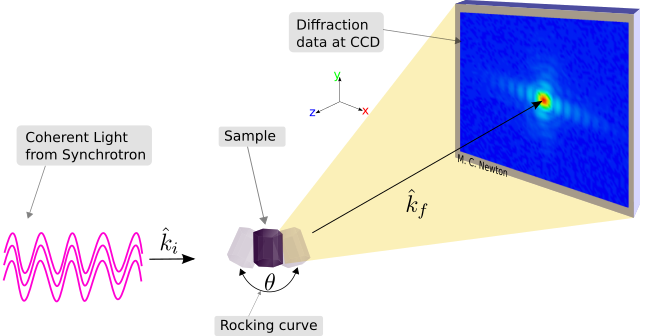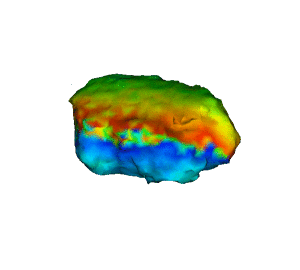Difference between revisions of "Research"
m (→Research) |
m (→Research) |
||
| Line 7: | Line 7: | ||
[[Image:BCXDI.png|thumb|center|950px|alt=Research Summary.|Experimental Geometry for Bragg Coherent X-ray Diffraction Imaging (BCXDI). ]] | [[Image:BCXDI.png|thumb|center|950px|alt=Research Summary.|Experimental Geometry for Bragg Coherent X-ray Diffraction Imaging (BCXDI). ]] | ||
| − | [[Image:AniAu.gif|frameless|300px | + | [[Image:AniAu.gif|frameless|300px]] |
Our group's research is focused on the study of nanomaterials using Bragg coherent X-ray diffraction imaging (BCXDI). BCXDI is a lens-less far field imaging technique that allows imaging of nanometre scale crystalline materials with a sensitivity below a single angstrom. It is largely non-destructive and provides strain information at the surface and throughout the bulk of a material. Conventional BCXDI is performed by illuminating a sample with a spatially coherent X-ray source (a synchrotron X-ray light source) so that the coherence volume exceeds the dimensions of the nanocrystal (~ 1 micron). In the Bragg reflection geometry, scattered light from the entire volume of the crystal interferes in the far-field, producing a three-dimensional k-space diffraction pattern. Iterative phase reconstruction methods (see [[#Non-linear Phase Retrieval Optimisation|Non-linear Phase Retrieval Optimisation]], below) are then used to recover the complex three-dimensional electron density and phase information. The displacement of ions throughout the bulk is directly related to the phase and can be used to obtain three-dimensional strain tensor information (M. Newton ''et al.'' Nature Materials (2010)). BCXDI experiments are conducted at synchrtron facilities including the Diamond Light Source (DLS), European Synchrotron Radiation Facility (ESRF), Advanced Photon Source APS, Spring-8 and the SACLA X-ray free electron laser (XFEL) facility. | Our group's research is focused on the study of nanomaterials using Bragg coherent X-ray diffraction imaging (BCXDI). BCXDI is a lens-less far field imaging technique that allows imaging of nanometre scale crystalline materials with a sensitivity below a single angstrom. It is largely non-destructive and provides strain information at the surface and throughout the bulk of a material. Conventional BCXDI is performed by illuminating a sample with a spatially coherent X-ray source (a synchrotron X-ray light source) so that the coherence volume exceeds the dimensions of the nanocrystal (~ 1 micron). In the Bragg reflection geometry, scattered light from the entire volume of the crystal interferes in the far-field, producing a three-dimensional k-space diffraction pattern. Iterative phase reconstruction methods (see [[#Non-linear Phase Retrieval Optimisation|Non-linear Phase Retrieval Optimisation]], below) are then used to recover the complex three-dimensional electron density and phase information. The displacement of ions throughout the bulk is directly related to the phase and can be used to obtain three-dimensional strain tensor information (M. Newton ''et al.'' Nature Materials (2010)). BCXDI experiments are conducted at synchrtron facilities including the Diamond Light Source (DLS), European Synchrotron Radiation Facility (ESRF), Advanced Photon Source APS, Spring-8 and the SACLA X-ray free electron laser (XFEL) facility. | ||
Revision as of 16:29, 13 September 2017
Contents
Research
Coherent X-ray Imaging
Our group's research is focused on the study of nanomaterials using Bragg coherent X-ray diffraction imaging (BCXDI). BCXDI is a lens-less far field imaging technique that allows imaging of nanometre scale crystalline materials with a sensitivity below a single angstrom. It is largely non-destructive and provides strain information at the surface and throughout the bulk of a material. Conventional BCXDI is performed by illuminating a sample with a spatially coherent X-ray source (a synchrotron X-ray light source) so that the coherence volume exceeds the dimensions of the nanocrystal (~ 1 micron). In the Bragg reflection geometry, scattered light from the entire volume of the crystal interferes in the far-field, producing a three-dimensional k-space diffraction pattern. Iterative phase reconstruction methods (see Non-linear Phase Retrieval Optimisation, below) are then used to recover the complex three-dimensional electron density and phase information. The displacement of ions throughout the bulk is directly related to the phase and can be used to obtain three-dimensional strain tensor information (M. Newton et al. Nature Materials (2010)). BCXDI experiments are conducted at synchrtron facilities including the Diamond Light Source (DLS), European Synchrotron Radiation Facility (ESRF), Advanced Photon Source APS, Spring-8 and the SACLA X-ray free electron laser (XFEL) facility.
Correlated electronic materials are those which the interaction between the valence electrons can strongly influence the materials properties. They are interesting as their unique properties are of considerable utility for device physics, functional materials and the study of fundamental condensed matter physics. Recently, there has been renewed interest in materials that exhibit a solid-solid structural phase transition at a critical temperature. Some of these materials exhibit a reconstructive structural phase transition (SPT) at some critical temperature that occurs on the femto-second time scale. There is still a great deal that is not known about the dynamics of this phenomenon as the ability to probe ultra-fast transitions remains largely inaccessible to conventional techniques. An example is vanadium dioxide (VO2), where spontaneous (non-diffusion limited) atomic rearrangement occurs due to external excitation (M. Newton et al. Nano Letters (2014)). Switching speeds on the femto-second timescale have been observed.
To study these materials, our group makes use of femto-second coherent X-ray diffraction imaging to study ultra-fast SPT's in nanoscale materials. This process became possible with the advent of the X-ray Free Electron Laser (XFEL) synchrotron radiation facility. Here we combine Bragg coherent X-ray diffraction imaging (BCXDI) with a cross-correlated femto-second pump-probe scheme that allows us to image structural changes with a time resolution of the order of a few femto-seconds. BCXDI is a powerful lens-less imaging technique for probing crystalline materials with sub-nanometre sensitivity. When BCXDI imaging is performed using the femto-second timing of an XFEL, we can obtain three-dimensional images of nanoscale structures with femto-second temporal resolution and nanometre spatial resolution. As a result, we are able to address the fundamental problem of how to determine atomic motions during a SPT in solid-phase materials. Our findings will likely aid in the development of a dynamical theory that can fully describe this structural change.
Ab Inito Molecular Dynamics
Our group is also engaged in large scale supercomputer simulations of structural phase transitions. We make use of the Iridis high-performance computing facility to perform ab-initio molecular dynamics (MD) simulations of structural phase transitions under various conditions. Simulations of the ultra-fast SPT allow us to bridge XFEL experiments to current theory and to make predictions as to how the behaviour of a material changes under various conditions. This might relate to a change in the immediate environment of the material or the materials use in a heterostructure device setting. To the right is an animation resulting from an ab-initio simulation of a supercell of vanadium dioxide undergoing a structural phase transition from monoclinic to tetragonal crystal structure (D. Plasienka et al. Phys. Rev. B (2017)).
Strong Phase Structures

Strain engineering plays an important role in the development of devices in the semiconductor industry today. It is also utilised directly in a number of device applications including piezoelectric actuators and sensors. When the amount of strain exceeds a certain limit (unique to each material), the accompanying strong phase structure makes strain mapping challenging. This research topic aims to investigate the origin of strong phase structures in nanometre scale materials and how they impact the CXD imaging process. We do so by systematically studying the transition into the strong phase structure regime. Results obtained here are also of value in developing advanced numerical optimisation techniques for phase recovery.
Non-linear Phase Retrieval Optimisation
When Bragg coherent X-ray diffraction imaging (BCXDI) measurements are performed, phase information is in general lost as only intensity measurements can be made. It therefore becomes necessary to reconstruct the phase information subject to some a priori information. In general phase retrieval methods operate by the application of iterative projective algorithms that cause the objective function to converge toward the optimal solution by the repeated application of constraints at each iteration. One important application of phase retrieval methods is to obtain real-space images of nanoscale structures by inverting measured diffraction patterns. Correlated electronic materials that undergo a spontaneous crystalline deformation can experience a significant strain. This can pose a challenge when reconstructing and interpreting phase information obtained from BCXDI. We have previously shown that materials exhibiting strong phase structure require special optimisation methods to reconstruct the real-space object. Our group is continuing to develop algorithms to reconstruct data known to have strong phase structure. Significant developments here will lead to robust algorithms that are universally effective. We have also developed the Interactive Phase Retrieval Suite, the first software package that allows for real-time visualisation of the reconstruction of phase information in both two and three dimensions. This is used for analysing diffraction patterns obtained from coherent X-ray imaging experiments and for algorithm development.
Nanomaterials and Devices
The increasing need to make smaller device structures with enhanced functionality has led the move away from conventional top-down lithographic approaches toward the utilisation of self-assembled nanoscale structures. The unique morphologies exhibited by many nanocrystals make them ideal for various applications including biochemical sensors, photodetectors, light emitters, transistors, high frequency oscillators, and waveguides. Our research into nanomaterials and devices is centred on self-assembled metal-oxide nanocrystals which have the advantage of high chemical resistance and low thermal degradance. This includes group II-VI semiconductor materials such as zinc oxide (M. Newton et al. Materials Today (2007)).



